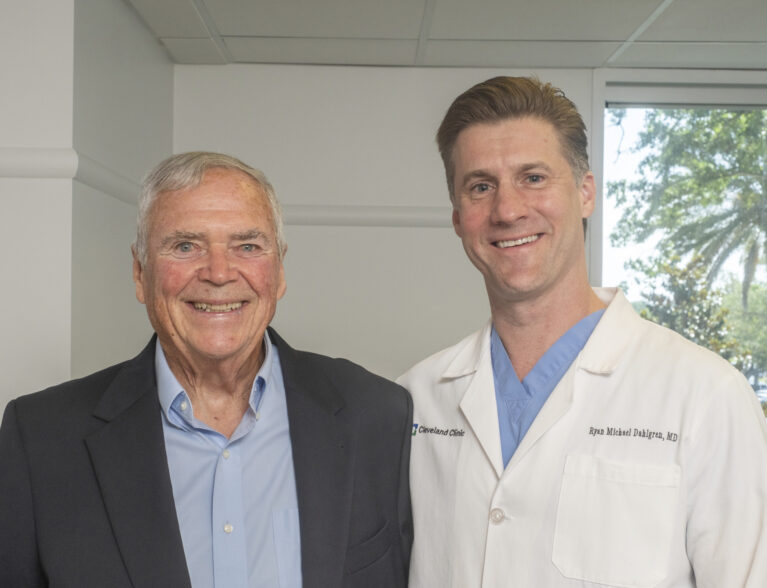
It’s hard to call someone lucky who has had two strokes, but the term can be justly applied in Luis Klein’s case in the sense that Dr. Ryan Dahlgren and the neuro-endovascular team Cleveland Clinic Indian River Hospital saved his life both times in harrowing circumstances.
“My first stroke was in June 2023,” Klein recalled. “I got my coffee ready and went back into the bedroom because I wasn’t feeling well. I sensed a stroke coming on and tried to call my wife, but I couldn’t say anything. My dog alerted my wife, and she immediately called 911.”
Paramedics rushed him to Cleveland Clinic, where doctors discovered a blockage in the left hemisphere of his brain.
“I was unconscious, but when I woke up, I was in the interventional lab with numerous doctors around me,” Klein said. “The lifesaving procedure took about 40 minutes, and within six hours, I was fully recovered from a cryptogenic stroke. I stayed in the hospital for a few days for testing and was sent home with some medications, like baby aspirin.”
For the next 18 months, Klein resumed life as usual with no residual effects – until one afternoon in February when he felt the left side of his face go numb while sitting on the couch. Suspecting a stroke, he alerted his wife, who again called 911 and also reached out to her son, a fire department lieutenant.
Aware of CCIRH’s advanced stroke care, the son instructed paramedics to bypass the nearest hospital and take Klein straight to Cleveland Clinic.
By the time they arrived, Klein was fully conscious and no longer displaying signs of a stroke. Still, a stroke alert was activated.
“As he came into the emergency room, a stroke alert was initiated in conjunction with the paramedics,” said Dr. Dahlgren. “That allowed us to image the patient using our advanced CT technology. We found a clot completely blocking blood flow to the basilar artery, which supplies the base of the brain. If that part of the brain dies, it’s a non-survivable stroke.”
According to the American Heart Association, basilar artery occlusion is one of the most catastrophic forms of stroke, with mortality rates exceeding 85 percent. It occurs when the artery supplying blood to the brainstem becomes blocked, cutting off critical blood flow to the brain’s control center.
“The basilar artery supports all your basic life functions,” Dr. Dahlgren explained. “The initial blockage in his neck caused him to pass out and collapse. Thanks to the rapid response by his wife and the paramedics, some blood flow managed to squeeze past the clot, reviving him. Even though he wasn’t showing major symptoms, our team doesn’t miss strokes. He was immediately put through our stroke protocol for imaging and evaluation.”
That protocol revealed that the clot had migrated upward and was now lodged in the basilar artery, restricting blood flow like a cork in a wine bottle.
“The imaging showed that just a trickle of blood was getting through,” Dr. Dahlgren said.
An ER physician called Dr. Dahlgren, telling him that although a clot had been spotted in the basilar artery, Klein seemed perfectly fine – scoring just a level 1 on the NIH Stroke Scale. But Dr. Dahlgren knew action was needed to save Klein a second time.
“I told them he wouldn’t be fine for long and instructed them to activate the keystroke team, which includes stroke specialists from Cleveland Clinic in Ohio,” he said. “With the push of a button, we had world-class neurologists connected via video, examining Mr. Klein in real time and guiding next steps.”
As doctors discussed potential clot-busting medication with the tele-neurologist, Dr. Dahlgren summoned his endovascular surgical team to the hospital.
Then things took a sudden and terrifying turn.
“Suddenly, Mr. Klein lost all motor function in his arms and legs. He stopped breathing and went into a life-ending seizure,” Dr. Dahlgren said. “We immediately transferred him to our interventional surgical suite. From the initial incision to restoring blood flow, the entire life-saving procedure took only 12 minutes.”
Remarkably, Klein made a full recovery and was discharged just 48 hours later.
“What makes this case so extraordinary is that we were able to detect and treat a life-threatening stroke before it caused any brain damage,” Dr. Dahlgren said. “There wasn’t even a single dot on his MRI – his brain was perfect. If he’d gone to a hospital without the right interventional tools or neuro-endovascular team, he likely would not have survived.”
Nearly 800,000 Americans experience a stroke each year. National data lists stroke as the fourth-leading cause of death and the primary cause of serious, long-term disability in the United States.
But timely treatment can lessen or even reverse the effects of a stroke. CCIRH’s expert stroke and cerebrovascular team provides advanced, state-of-the-art care with specialized, minimally invasive treatments designed to offer the best possible results, according to the hospital.
“I am eternally grateful to Cleveland Clinic and Dr. Dahlgren for saving my life twice,” Klein said. “Now I’m able to enjoy my family and my grandchildren again.”
Dr. Ryan Dahlgren is the Medical Director of Neuro Endovascular Surgery at CCIRH. He completed his medical education, internship, and residency at the University of Oklahoma College of Medicine. He then pursued fellowships in Neuro Radiology at Jackson Memorial Hospital-University of Miami School of Medicine, and in Neuro Endovascular Surgery at Cleveland Clinic in Ohio. He is accepting new patients at the CCIRH Wellness Center. The phone number is 772-563-4741.



